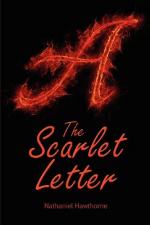|
This section contains 546 words (approx. 2 pages at 300 words per page) |

|
Heaven, Earth, and Hell in The Scarlet Letter
Summary: The scaffold scene positioning in the third chapter of Nathaniel Hawthorne's novel The Scarlet Letter shows how an author's placement of characters in a scene tells much about that character and his or her role in the story. In this scene, Hawthorne sets Hester Prynne, Dimmesdale, and Chillingworth at different elevations in the marketplace to symbolize the separate levels associated with the Puritan view of the religious world. Dimmesdale, above on the balcony, represents Heaven; Hester, below on the scaffold, represents Earth; and Chillingworth, blending with the crowd below, represents Hell.
The placement in which an author positions the characters in a scene can tell the reader a great deal about the character and their role in the story. In chapter three of The Scarlet Letter, by Nathaniel Hawthorne, the character arrangement in the scaffold scene at the market place gives the reader an insight into the characters' placement in society and within themselves. In this scene, Hester Prynne, the protagonist, is on the scaffold being questioned about the name of her baby's father by Revered Arthur Dimmesdale, Hester's secret lover and her baby's biological father, along with Reverend John Wilson and Governor Richard Bellingham on the balcony above her. Below the scaffold on which Hester is being displayed in shame as punishment for her sin of adultery, Roger Chillingworth, her missing husband and the antagonist of the story, stands watching and blending in with the crowd. Hawthorne lays...
|
This section contains 546 words (approx. 2 pages at 300 words per page) |

|


